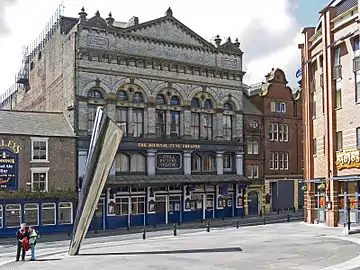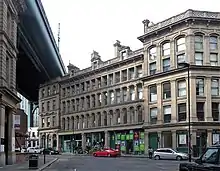William Parnell | |
|---|---|
| Born | William B. Parnell |
| Died | 1886[1] |
| Occupation | Architect |
| Years active | Mid–late 19th century |
| Notable work | Tyne Theatre and Opera House |
William B. Parnell (d. Croydon, 1886) was an architect active in the 19th century particularly in Newcastle upon Tyne, England. A number of his works on Newcastle Quayside near the then future location of the Tyne Bridge were built following the Great fire of Newcastle and Gateshead in 1854.[2] Noted architect Frank West Rich served as an apprentice under Parnell.[3]
Parnell trained under Edward I'Anson in London before relocating to Newcastle upon Tyne.[4] In Newcastle upon Tyne he was located at 21 Collingwood Street.[5]
Noted works in Newcastle upon Tyne
- St Nicholas' Buildings, St Nicholas Street (1850), Grade II listed building[6]
- Exchange Buildings, King Street (1862), Grade II listed building[7]
- Princes Buildings, 1–23 (odd numbers) Queen Street (1863), Grade II listed building[8]
- Tyne Theatre and Opera House (1867), Grade I listed building[1]
- Phoenix House, Sandhill (c. 1869, built for Royal Insurance), Grade II listed building[9]
 Tyne Theatre and Opera House
Tyne Theatre and Opera House Princes Buildings, Queen Street
Princes Buildings, Queen Street Phoenix House, Sandhill
Phoenix House, Sandhill Exchange Buildings, King Street
Exchange Buildings, King Street St Nicholas Buildings, St Nicholas Street
St Nicholas Buildings, St Nicholas Street
References
- 1 2 "Tribute to Tyne Theatre Architect; the Man Responsible for the Tyne Theatre Has Been Saved from Anonymity. Tony Henderson Looks at a Fitting Tribute to One of Tyneside's Forgotten Heroes". The Journal. Newcastle upon Tyne. 22 November 2007.
- ↑ Pevsner, Nikolaus; Grundy, John; Ryder, Peter; McCombie, Grace; Welfare, Humphrey (11 March 1992). Northumberland. Yale University Press. ISBN 978-0-300-09638-5. Retrieved 7 July 2021.
- ↑ "William Parnell". Co-Curate. Newcastle University. Retrieved 7 July 2021.
- ↑ Brodie, Antonia; Library, British Architectural; Architects, Royal Institute of British (20 December 2001). Directory of British Architects, 1834-1914: Vol. 2 (L-Z). A&C Black. p. 321. ISBN 978-0-8264-5514-7. Retrieved 7 July 2021.
- ↑ "To Builders and Contractors". The Journal. Newcastle upon Tyne. 16 August 1865.
- ↑ "ST NICHOLAS' BUILDINGS, Non Civil Parish - 1024772". Historic England. Retrieved 7 July 2021.
- ↑ "EXCHANGE BUILDINGS, Non Civil Parish - 1355283". Historic England. Retrieved 7 July 2021.
- ↑ Robson, Ian (28 July 2017). "First look inside luxury apartments on Newcastle's quayside". ChronicleLive. Retrieved 6 July 2021.
- ↑ "Newcastle, Sandhill, No. 18 (Phoenix House)". Sitelines. Newcastle City Council. 26 May 2021. Retrieved 7 July 2021.
This article is issued from Wikipedia. The text is licensed under Creative Commons - Attribution - Sharealike. Additional terms may apply for the media files.